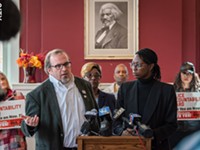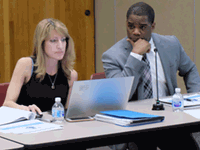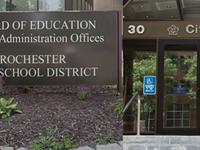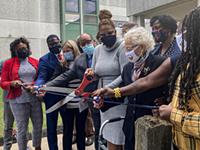[
{
"name": "500x250 Ad",
"insertPoint": "5",
"component": "15667920",
"parentWrapperClass": "",
"requiredCountToDisplay": "1"
}
]
(Second of two columns on five decades of Rochester school reform efforts.)
Will the Rochester school district ever be able to do its job?
Over the 48 years we’ve been publishing CITY, the district has tried almost everything. So has the larger community. And yet far too many children still leave school without the knowledge and skills to live productive adult lives.
 We’ve made progress, as school board President Van White reminded me last week. The graduation rate is up. Suspensions are down. And yet the district still lags behind other districts in the state – including other urban districts.
We’ve made progress, as school board President Van White reminded me last week. The graduation rate is up. Suspensions are down. And yet the district still lags behind other districts in the state – including other urban districts.
Have we simply tried the wrong things? Sometimes. But we’ve tried quite a few of the right things, and we either didn’t execute them well or our efforts were overwhelmed by larger forces.
The district has two kinds of problems: internal and external. We ought to be able to fix the internal problems – too little accountability, too little training, too little follow-through on good initiatives, and a finger-pointing attitude in the district – but they have continued for decades.
A small side rant here: The finger pointing is terribly destructive, and I’ll offer this humble suggestion for ending it. Everybody in this district needs to withdraw to their own corner, look their own faults in the eye, and focus on addressing them. Members of the teachers union should spend a year facing the weaknesses in their own ranks, devising specific plans for fixing them, and holding one another accountable. Members of the administrators union, the superintendent’s top executives, community activists, and the school board should do the same. No alibis, no excuses, no finger pointing.
Parent leaders should spend a year focusing solely on parent responsibilities. No complaining about whether schools are welcoming, the curriculum is relevant, and the tests are too stressful. All of that needs reforming, yes, but parents have responsibilities, too.
Also on the internal-problems list: the frequent change in superintendents and top-level administrators. The district brings in new superintendents every few years, each with new ideas, new approaches. But the district’s problems are deep, and fixing them takes time. Even the brightest, strongest, best-loved leader needs time to bring meaningful change to a district Rochester’s size. Instead, for the last several decades, the pattern has been one of frequent change.
Going through my files over the past few weeks, I came across a 10-year-old email exchange with former school board president Rob Brown. I had asked Brown why one particular promising initiative had failed. “Maybe one problem,” he wrote back, “is lack of long-term consistency.” We haven’t been able to retain good superintendents and good principals, he said. And if we can’t, “I don’t think we can expect their innovations to bear the fruit that comes from long-term nurturing fertilization, and pruning.”
“Excellent and experienced long-term teachers complain bitterly about the number of short-lived, ‘here today gone tomorrow’ theories and programs that are visited on them by central office,” Brown said. “It’s one reason why they are almost universally disaffected with so-called ‘professional development.’”
If the internal problems were fixed, student achievement would increase. There’s no doubt about that. But then there are the external problems.
There's a widespread belief that the school district alone is at fault and that it alone has to solve the achievement problem. Sure, every great once in a while, some parts of the larger community have their conscience pricked and we get powerfully worded reports calling on the entire community to get involved. But for the most part, these reports call for the community to get involved inside the school district – within the confines of the district and its concentrated poverty.
Elected officials and community leaders issue calls for volunteer tutors, for 10,000 mentors, not for more high-quality child care, not for money for smaller classes and more social services and health care, and most assuredly not for proven, effective ways to boost the education of disadvantaged children: economically integrated schools and housing.
The systemic problems of concentrated poverty and racism have trapped the community’s poorest children in extremely poor neighborhoods and high-poverty schools. And that has had has an impact. Worse, Rochester’s poverty is generational poverty – successive generations of families living in stressful neighborhoods, under stressful conditions; successive generations of parents who themselves haven’t had a good education.
In my clip files is a 2005 article by Messenger-Post columnist Benjamin Wachs. The subject: RIT President Al Simone’s idea for finding 10,000 mentors for city students. Simone wasn’t going to round up the mentors, Wachs reported. He wanted then-mayor Bill Johnson to do it, and Johnson was skeptical. The reason: He had already tried creating a mentoring program, in his days as president of the Urban League. He and nine other men mentored thirty 7- and 8-year-old boys in 1989. It wasn’t successful.
“Even as the head of the Urban League,” Wachs wrote, “Johnson was astonished by the black hole of need these kids came from.”
“If a kid has been traumatized,” Johnson asked Wachs, “what good is a volunteer? We have a large population living in enforced depravity.”
“His mentors,” Wachs wrote, “became exhausted trying to make up for everything society hadn’t provided.”
When I talked with Johnson about that a couple of weeks ago, he noted an often-overlooked aspect of the district’s poverty and segregation. Middle-income families of color have more school options than poor families have, and many of them don’t live in the city. Their children can go to suburban schools, none of which are high-poverty schools. In addition, the Urban-Suburban program and the growing number of charter schools offer options, and middle-income, better-educated city parents are able to better navigate those choices.
“So the school district,” Johnson said, “is put in the unfortunate position” of educating the children with the greatest needs, children whose parents are less engaged in their education and “don’t know how to work the system.”
The solution: “We need to effectively disband the school system – essentially create a new school structure,” Johnson said.
Rochester’s problem “is a systemic problem,” he said. “Until we say we are going to reorganize the schools in a way that we do not put all the poor children in one district....” But that will require participation by suburban school districts, and that’s simply not going to happen. As Johnson says, anybody who mentions that is met with “ferocity and intensity.”
To get a stellar example of how tough it’ll be to start breaking down the district’s poverty concentration, you have only to turn to the experience of Great Schools for All. That organization has been trying for more than four years to get school districts interested in creating "socioeconomically diverse magnet schools open to students from across Monroe County.” Great Schools members aren’t talking about a metro school district. They’re not talking about forcing any child to attend one of the magnet schools. They just hope to convince the Rochester district and suburban districts to create schools that would draw students – voluntarily – from high-poverty city neighborhoods and from the suburbs.
To this date, they haven’t gotten a single suburban commitment. That is shameful.
Significantly, school integration isn’t popular with many families of color. And a good number of African-American public officials and community activists are adamant: Poor children of color shouldn’t have to go to school with white, more affluent children in order to get a good education, they say.
Of course they shouldn’t. But economic integration is a proven way to help those children. If we’re going to overcome the effects of concentrated poverty without breaking down that concentration, then we’ll have to attack poverty’s effects. That will be expensive. It will take a long time. And nobody is willing to invest either the time or the money that it will require.
It’s easier to just blame the teachers, the union president, the school board, the superintendent. And the community has been doing that for every one of the 48 years we’ve been publishing CITY.
So will the Rochester school district ever be able to do its job properly and give Rochester’s children the education they deserve? Not in my lifetime, I’m afraid. Not in my lifetime. And to me, that is sinful, in the Biblical sense of that word.
Will the Rochester school district ever be able to do its job?
Over the 48 years we’ve been publishing CITY, the district has tried almost everything. So has the larger community. And yet far too many children still leave school without the knowledge and skills to live productive adult lives.
Related The more things change: 48 years with the RCSD

The more things change: 48 years with the RCSD
As we look for ways to give Rochester's children a good education, what will we try that we haven’t tried before?
Urban Journal
Have we simply tried the wrong things? Sometimes. But we’ve tried quite a few of the right things, and we either didn’t execute them well or our efforts were overwhelmed by larger forces.
The district has two kinds of problems: internal and external. We ought to be able to fix the internal problems – too little accountability, too little training, too little follow-through on good initiatives, and a finger-pointing attitude in the district – but they have continued for decades.
A small side rant here: The finger pointing is terribly destructive, and I’ll offer this humble suggestion for ending it. Everybody in this district needs to withdraw to their own corner, look their own faults in the eye, and focus on addressing them. Members of the teachers union should spend a year facing the weaknesses in their own ranks, devising specific plans for fixing them, and holding one another accountable. Members of the administrators union, the superintendent’s top executives, community activists, and the school board should do the same. No alibis, no excuses, no finger pointing.
Parent leaders should spend a year focusing solely on parent responsibilities. No complaining about whether schools are welcoming, the curriculum is relevant, and the tests are too stressful. All of that needs reforming, yes, but parents have responsibilities, too.
Also on the internal-problems list: the frequent change in superintendents and top-level administrators. The district brings in new superintendents every few years, each with new ideas, new approaches. But the district’s problems are deep, and fixing them takes time. Even the brightest, strongest, best-loved leader needs time to bring meaningful change to a district Rochester’s size. Instead, for the last several decades, the pattern has been one of frequent change.
Going through my files over the past few weeks, I came across a 10-year-old email exchange with former school board president Rob Brown. I had asked Brown why one particular promising initiative had failed. “Maybe one problem,” he wrote back, “is lack of long-term consistency.” We haven’t been able to retain good superintendents and good principals, he said. And if we can’t, “I don’t think we can expect their innovations to bear the fruit that comes from long-term nurturing fertilization, and pruning.”
“Excellent and experienced long-term teachers complain bitterly about the number of short-lived, ‘here today gone tomorrow’ theories and programs that are visited on them by central office,” Brown said. “It’s one reason why they are almost universally disaffected with so-called ‘professional development.’”
If the internal problems were fixed, student achievement would increase. There’s no doubt about that. But then there are the external problems.
There's a widespread belief that the school district alone is at fault and that it alone has to solve the achievement problem. Sure, every great once in a while, some parts of the larger community have their conscience pricked and we get powerfully worded reports calling on the entire community to get involved. But for the most part, these reports call for the community to get involved inside the school district – within the confines of the district and its concentrated poverty.
Elected officials and community leaders issue calls for volunteer tutors, for 10,000 mentors, not for more high-quality child care, not for money for smaller classes and more social services and health care, and most assuredly not for proven, effective ways to boost the education of disadvantaged children: economically integrated schools and housing.
The systemic problems of concentrated poverty and racism have trapped the community’s poorest children in extremely poor neighborhoods and high-poverty schools. And that has had has an impact. Worse, Rochester’s poverty is generational poverty – successive generations of families living in stressful neighborhoods, under stressful conditions; successive generations of parents who themselves haven’t had a good education.
In my clip files is a 2005 article by Messenger-Post columnist Benjamin Wachs. The subject: RIT President Al Simone’s idea for finding 10,000 mentors for city students. Simone wasn’t going to round up the mentors, Wachs reported. He wanted then-mayor Bill Johnson to do it, and Johnson was skeptical. The reason: He had already tried creating a mentoring program, in his days as president of the Urban League. He and nine other men mentored thirty 7- and 8-year-old boys in 1989. It wasn’t successful.
“Even as the head of the Urban League,” Wachs wrote, “Johnson was astonished by the black hole of need these kids came from.”
“If a kid has been traumatized,” Johnson asked Wachs, “what good is a volunteer? We have a large population living in enforced depravity.”
“His mentors,” Wachs wrote, “became exhausted trying to make up for everything society hadn’t provided.”
When I talked with Johnson about that a couple of weeks ago, he noted an often-overlooked aspect of the district’s poverty and segregation. Middle-income families of color have more school options than poor families have, and many of them don’t live in the city. Their children can go to suburban schools, none of which are high-poverty schools. In addition, the Urban-Suburban program and the growing number of charter schools offer options, and middle-income, better-educated city parents are able to better navigate those choices.
“So the school district,” Johnson said, “is put in the unfortunate position” of educating the children with the greatest needs, children whose parents are less engaged in their education and “don’t know how to work the system.”
The solution: “We need to effectively disband the school system – essentially create a new school structure,” Johnson said.
Rochester’s problem “is a systemic problem,” he said. “Until we say we are going to reorganize the schools in a way that we do not put all the poor children in one district....” But that will require participation by suburban school districts, and that’s simply not going to happen. As Johnson says, anybody who mentions that is met with “ferocity and intensity.”
To get a stellar example of how tough it’ll be to start breaking down the district’s poverty concentration, you have only to turn to the experience of Great Schools for All. That organization has been trying for more than four years to get school districts interested in creating "socioeconomically diverse magnet schools open to students from across Monroe County.” Great Schools members aren’t talking about a metro school district. They’re not talking about forcing any child to attend one of the magnet schools. They just hope to convince the Rochester district and suburban districts to create schools that would draw students – voluntarily – from high-poverty city neighborhoods and from the suburbs.
To this date, they haven’t gotten a single suburban commitment. That is shameful.
Significantly, school integration isn’t popular with many families of color. And a good number of African-American public officials and community activists are adamant: Poor children of color shouldn’t have to go to school with white, more affluent children in order to get a good education, they say.
Of course they shouldn’t. But economic integration is a proven way to help those children. If we’re going to overcome the effects of concentrated poverty without breaking down that concentration, then we’ll have to attack poverty’s effects. That will be expensive. It will take a long time. And nobody is willing to invest either the time or the money that it will require.
It’s easier to just blame the teachers, the union president, the school board, the superintendent. And the community has been doing that for every one of the 48 years we’ve been publishing CITY.
So will the Rochester school district ever be able to do its job properly and give Rochester’s children the education they deserve? Not in my lifetime, I’m afraid. Not in my lifetime. And to me, that is sinful, in the Biblical sense of that word.
Speaking of...
Latest in Urban Journal
More by Mary Anna Towler
-

Police reform: advocates on what should come next
Oct 22, 2019 -

Court clears the way for Police Accountability referendum
Oct 17, 2019 -

Dade outlines initial actions on district deficit
Oct 9, 2019 - More »








